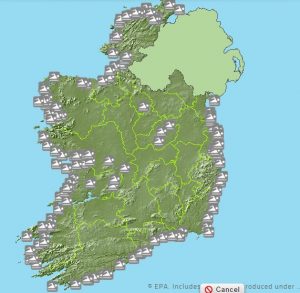An EPA report, Bathing Water Quality in Ireland – A Report for the Year 2016, has found that the overall quality of Ireland’s bathing waters remains very good with 130 of 140 identified waters meeting strict EU standards. The strict standards provide a high level of protection for bathers. Three quarters of bathing waters were classed as excellent, one more than 2015. However, six coastal bathing waters failed to meet the minimum standard and are classified as poor.
 Speaking at the launch of the report, Dr Matt Crowe, Director of the Environmental Protection Agency’s (EPA) Office of Evidence and Assessment said,
Speaking at the launch of the report, Dr Matt Crowe, Director of the Environmental Protection Agency’s (EPA) Office of Evidence and Assessment said,
“All bathers are entitled to feel that they and their loved ones are safe from harm from the water they swim in when they spend a day at the beach. More needs to be done to provide a greater level of protection for bathers at beaches and other bathing areas vulnerable to pollution. It is simply unacceptable to have popular bathing areas classified as being of poor quality.”
The 2016 report found that:
- In 2016, 92.9% of bathing waters (130 of 140) complied with EU minimum standards and were classified as achieving at least ‘Sufficient’ status.
- Three quarters of bathing waters (102 of 140, 72.9%) were classified as ‘Excellent’.
- A further 18 (12.9%) were classified as ‘Good’.
- 10 bathing areas (7.1%) were classified as being of ‘Sufficient’ water quality but remain at risk of episodic pollution events.
- 1 bathing water (Ardmore) was classed as ‘Changes’ pending full assessment of the performance of a new wastewater treatment plant.
- 6 bathing waters (4.3%) failed to meet the minimum required standard and were classified as being of ‘Poor’ quality. These were Ballyloughane (Galway City Council); Merrion Strand (Dublin City Council); Loughshinny (Fingal County Council); Portrane (Fingal County Council); Tran a bhForbacha (Galway County Council); Clifden (Galway County Council).
The 140 identified bathing waters are coastal or inland waters widely used by the public for bathing which are monitored, managed and assessed under the requirements of the 2008 Bathing Water Quality Regulations.
Peter Webster, EPA Senior Scientific Officer said,
“Ireland has no shortage of beaches around our coast with excellent water quality. In addition to the 140 EU identified bathing waters assessed in this report, we also include details of 80 other waters where bathing occurs which are monitored by local authorities. While these do not come under the legal framework of the Bathing Water Regulations it is important to let the public know about their water quality and we would like to see many of them included in the national monitoring programme in the future.”
Bathing waters are evaluated using a 4-year assessment period. This means their classification can be influenced by poorer results from previous bathing seasons. Three bathing waters classified as ‘Poor’ in 2016 – Ballyloughane, Merrion Strand, and Loughshinny – were also ‘Poor’ in 2015. The EPA report shows that these waters are all vulnerable to pollution events. The relevant local authorities, in conjunction with Irish Water, have plans in place to tackle the main pollution risks at these beaches with a view to improving them to at least ‘Sufficient’ quality.
Concluding, Peter Webster explained how the public could access current information about bathing water quality,
“Throughout the season, current water quality information and details of any incidents affecting bathing waters will be displayed on the national bathing water website, splash.epa.ie. Bathers visiting these waters are advised to check the website and their local beach notice boards for information on current water quality. A Twitter notification service, @EPABathingWater, is also available to provide incident alerts and information of interest to bathers.”
The summary report Bathing Water Quality in Ireland – A Report for the Year 2016 and map of the quality of Ireland’s bathing water sites are now available on the EPA website at http://www.epa.ie/pubs/
Bathing season: The bathing season in Ireland, is designated as being from 1st June to 15Th September.
Assessment: From 2014 onwards bathing water compliance requires assessments to be undertaken using a statistical methodology using data covering a four year period as opposed to previous annual assessments based on percentage compliance. The new standards are approximately twice as strict as previous ones.
Classification: Bathing areas are currently classified in one of four categories namely ‘Excellent’, ‘Good’, ‘Sufficient’ or ‘Poor’. The mandatory requirement is for ‘Sufficient’ quality. Any waters graded as ‘Poor’ require that management measures be put in place to identify and eliminate the sources of pollution. Where waters have shown a significant improvement but have fewer than 16 samples post-change they can be classed as ‘Changes’ until sufficient results are available for full classification. Similarly newly identified waters need to have 16 samples taken before they are classified.
Bathing at sites classified as having ‘Poor’ water quality: The fact that any bathing water has been classified as ‘Poor’ means that there is a risk of periodic microbiological pollution which could potentially cause illness such as skin rashes or gastric upset. Under the Bathing Water Regulations, local authorities are required to put in place notifications for the entire bathing season advising the public against bathing. This could include a bathing prohibition if a serious pollution incident occurs.